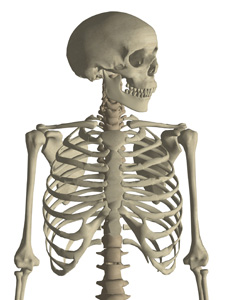Broken Sternum
Facts about a Broken Sternum
Fortunately, a broken sternum is not a common injury; generally occurring in cases of a blunt chest injury. This is often the result of a vehicle accident, as the driver strikes the steering wheel or dashboard of the vehicle. Not only is the injury quite painful but it can also be the cause for more serious internal injuries.
The sternum is part of the rib cage; a long bone that runs vertically from base of the neck to the abdominal region, also called the breastbone. It serves to hold the entire rib cage in position, as each rib encircling to the front of the body is affixed to the sternum with cartilage. It also connects with the clavicles that stretch from the upper sternum to the opposing shoulders. While the sternum is called a bone, the composition is actually mostly vascular tissue that features a hard, yet thin, dense bone covering.
Because of the sturdy nature of the breastbone and its location, causes of injuries to the sternum are usually limited to just a few scenarios. An accident in a motor vehicle is the leading cause; with the front seat occupants’ propulsion into the steering wheel or the vehicle’s dashboard creating a crushing blow to the chest. Wearing the seatbelt in a vehicle is normally a lifesaving act, but it can also be the reason for chest injury. Certain sports have the propensity for injuries to the breastbone; football, rugby, hockey and professional fighting are contact sports which encourage ramming into opponents to discourage advancement of play. Violence, whether domestic or random, that entails multiple blows directed to the chest area could also lead to an injury such as a broken sternum.
There are medical conditions that require the deliberate breaking of the sternum; namely, heart surgery. Cracking open the chest in order to access the heart that is protected within the rib cage is a necessary step, and one that will help to save the life of the patient. Although the recovery process is an extremely painful one, the long term outlook for the life of the patient greatly outweighs the short term pain.
Injuries to the sternum are identifiable through a number of symptoms. Pain around the center of the chest will likely be an immediate symptom, and may be heightened when a deep breath is taken or even during movement. Bruising of the skin on the chest, tenderness, swelling and finding it hard to breath can also be experienced. The extent of the injury will be determined through frontal and side chest x-rays, often followed by the administration of the CT scan.
When the injuries are limited to the sternum, an extended stay in the hospital is not generally required. Cardiac monitoring is the normal course of action following such an injury in the event myocardial contusion is present. Immobilizing the area is not an option for treatment, and victims of a broken sternum usually are treated with pain medications, anti-inflammatory medication and rest. The blows to the chest can result in more serious complications involving the lungs and heart, however. For these types of injuries, hospitalization is often recommended, with heart monitoring, oxygen and continuous supervision performed to avoid further issues. These additional health threats can increase the possibility of death when a sternum fracture is present, with the mortality rate for the victims at approximately 35%. Occasionally, sternum fractures are so severe that surgery is warranted and necessary. When an operation is needed, the bones of the sternum are simply placed back in position.
A broken sternum is, fortunately, not a situation most people need to consider. Although it is painful to endure, recovery is most often successful for this uncommon condition.
